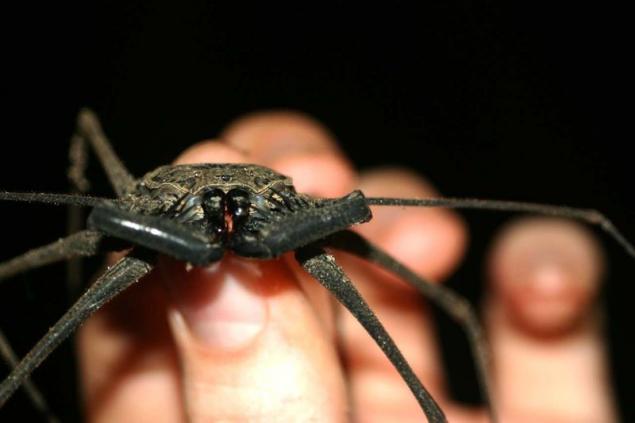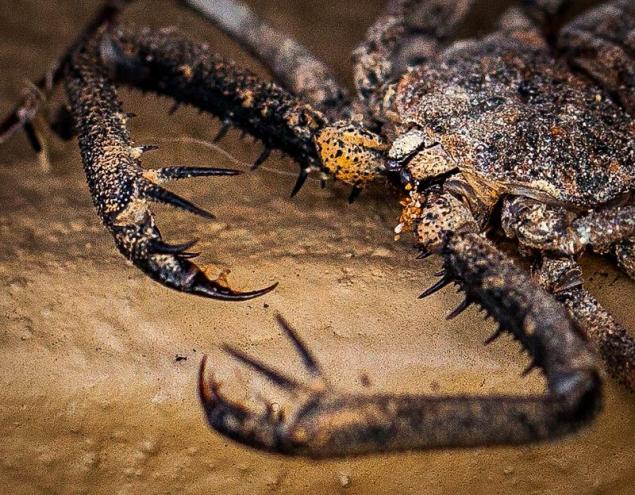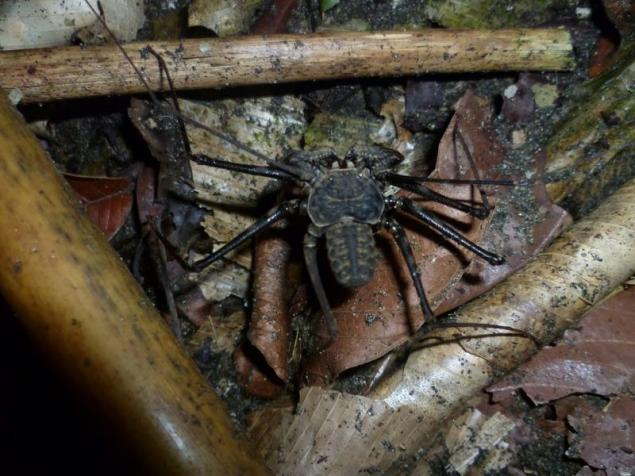10171
Tailless scorpions
Phryne (Amblypygi) - tailless zhgutonogie spiders are small detachment of tropical arachnids Amblypygi. Title squad in Greek means "dumb ass". In English-speaking countries called Phryne tailless scorpions because of the lack of the tail (telson).

Phryne are unique in that they have six walking legs, while other arachnids have eight. The reason for this is that the first of zhgutonogie spiders arachnids changed the walking legs in the senses. These long sensitive tentacles can be twice as long as the body and are used for environmental studies.

As Phryne active under conditions where penetrates very little sunlight, these modified legs are very important to them as a tool for learning about the world.

Another distinctive feature is their pedipalps in the form of a claw. These structures act as prehensile limbs usual mantis shrimp or mantis. Phryne use them to catch their prey, which they then crushed their mouthparts tentacles, so-called chelicerae.

Currently Systematics allocate 5 families, 17 genera and 136 species of Phryne, who live all over the world in tropical and subtropical countries. About them a lot of rumors and tales written many European and American writers. The reason for this was highly unusual and their complete absence in temperate countries.

Phryne were at all times incomprehensible and unpleasant ordinary people, so there's a lot about them fables. In some places, inhabited zhgutonogie spiders, locals are afraid of them and consider them extremely dangerous. For example, during his stay in the Seychelles in 1872, one biologist locals told us that after the bite Phryne there is swelling of the body, cramps and vomiting, and if not treated the victim with ammonia, it will eventually lead to long-term illness or death.

Even inspect imported to Europe samples of these arachnids, some scientists fear is so great their prejudice. One of the first authors who described Phryne, said that they can put a man seriously injured by a pedipalps, which may even lead to death after being bitten.

Yet no matter what wrote about these creatures, but they are completely harmless. Phryne prevented from biting or in any way harm the person. Zhgutonogie spiders are not poisonous, and their formidable pedipalps are used exclusively for capturing small prey such as tiny insects crawling on the trunks of trees.

Even today, the media have not taken any action to debunk the myth that Phryne dangerous to humans. For example, in the film version of "Harry Potter and the Goblet of Fire" zhgutonogie spiders are described as "deadly" animals, damn all-seeing eye. Phryne are rare guests on television because of its unusual "shocking" appearance. In the show "Fear Factor", the participants were forced to eat these creatures, proving that people are much more dangerous to zhgutonogih spiders than they are for us.

The vast majority of Freeney are nocturnal. Light of the day they spend in the cracks of trees or under stones. Some zhgutonogie spiders live only in caves.

Sometimes these fights turn into real fights, and males grasping each other and pushing. Battles end when one of Phryne runs from the battlefield or allow his opponent to step over him. If the winner and loser are together after the fight, the loser will be avoided, and the winner will gesture to show his obedience to avoid another battle.

Phryne - caring parents. And watch them at this time is extremely interesting. Newborns frinyata cling abdomen Nurse within a few days after birth. Then they fade and go away from the care of his mother. "Cub" zhgutonogogo spider, usually white immediately after birth, and thus, it becomes immediately apparent when Phrynichus bore.

Very little is known about zhgutonogih spiders. There are probably only about a dozen scientists around the world who are actively involved in the study of the peculiarities of their biology.

Recent studies in the laboratory using high-speed cameras and sound-precision equipment, showed that Phryne use sound to communicate during fights males (Santer and Hebets, 2008). This is due to vibration sensitive antennae. The opponent receives a signal through long sensitive hairs located on the kneecap of walking legs.

Phryne have flat calf adapted for prolezaniya in crevices and other hard to reach areas where they hide during daylight hours. Zhgutonogie spiders hunt at night, when they can be seen on tree trunks.
The picture shows that the prehensile limbs apart. Perhaps in this position Phryne waiting to ambush their prey. If disturb him, he pushes the foot of prey closer to the body.

Account for 136 species, 17 genera and 5 families Phryne. Are found they are in the tropics and subtropics. Phryne hygrophilous, so almost never leave the forest, where the day hiding under crop residues, peeled the bark and in the cracks of rocks. Some species are found in termite mounds. In the cave inhabitants (some species Phrynichus) reduced lateral eyes.

Phryne usually move sideways like a crab. In this one, "tendril" they sent to the direction of motion, and the other continuously feels the neighborhood.



About them a lot of rumors and tales written many European and American writers. The reason for this was highly unusual and their complete absence in temperate countries.

Phryne were at all times incomprehensible and unpleasant ordinary people, so there's a lot about them fables. In some places, inhabited zhgutonogie spiders, locals are afraid of them and consider them extremely dangerous. For example, during his stay in the Seychelles in 1872, one biologist locals told us that after the bite Phryne there is swelling of the body, cramps and vomiting, and if not treated the victim with ammonia, it will eventually lead to long-term illness or death.

Males have a very interesting way of establishing who is chief among them. When two males encounter each other, they are involved in some sort of "fighting" tournaments. They usually face pedipalps, and try to push their long front legs.
Scientific classification:
Kingdom: Animals
Type: Arthropods
Subtype: Chelicerata
Class: Arachnids
Order: Phryne (Amblypygi)
Source: masterok.livejournal.com

Phryne are unique in that they have six walking legs, while other arachnids have eight. The reason for this is that the first of zhgutonogie spiders arachnids changed the walking legs in the senses. These long sensitive tentacles can be twice as long as the body and are used for environmental studies.

As Phryne active under conditions where penetrates very little sunlight, these modified legs are very important to them as a tool for learning about the world.

Another distinctive feature is their pedipalps in the form of a claw. These structures act as prehensile limbs usual mantis shrimp or mantis. Phryne use them to catch their prey, which they then crushed their mouthparts tentacles, so-called chelicerae.

Currently Systematics allocate 5 families, 17 genera and 136 species of Phryne, who live all over the world in tropical and subtropical countries. About them a lot of rumors and tales written many European and American writers. The reason for this was highly unusual and their complete absence in temperate countries.

Phryne were at all times incomprehensible and unpleasant ordinary people, so there's a lot about them fables. In some places, inhabited zhgutonogie spiders, locals are afraid of them and consider them extremely dangerous. For example, during his stay in the Seychelles in 1872, one biologist locals told us that after the bite Phryne there is swelling of the body, cramps and vomiting, and if not treated the victim with ammonia, it will eventually lead to long-term illness or death.

Even inspect imported to Europe samples of these arachnids, some scientists fear is so great their prejudice. One of the first authors who described Phryne, said that they can put a man seriously injured by a pedipalps, which may even lead to death after being bitten.

Yet no matter what wrote about these creatures, but they are completely harmless. Phryne prevented from biting or in any way harm the person. Zhgutonogie spiders are not poisonous, and their formidable pedipalps are used exclusively for capturing small prey such as tiny insects crawling on the trunks of trees.

Even today, the media have not taken any action to debunk the myth that Phryne dangerous to humans. For example, in the film version of "Harry Potter and the Goblet of Fire" zhgutonogie spiders are described as "deadly" animals, damn all-seeing eye. Phryne are rare guests on television because of its unusual "shocking" appearance. In the show "Fear Factor", the participants were forced to eat these creatures, proving that people are much more dangerous to zhgutonogih spiders than they are for us.

The vast majority of Freeney are nocturnal. Light of the day they spend in the cracks of trees or under stones. Some zhgutonogie spiders live only in caves.

Sometimes these fights turn into real fights, and males grasping each other and pushing. Battles end when one of Phryne runs from the battlefield or allow his opponent to step over him. If the winner and loser are together after the fight, the loser will be avoided, and the winner will gesture to show his obedience to avoid another battle.

Phryne - caring parents. And watch them at this time is extremely interesting. Newborns frinyata cling abdomen Nurse within a few days after birth. Then they fade and go away from the care of his mother. "Cub" zhgutonogogo spider, usually white immediately after birth, and thus, it becomes immediately apparent when Phrynichus bore.

Very little is known about zhgutonogih spiders. There are probably only about a dozen scientists around the world who are actively involved in the study of the peculiarities of their biology.

Recent studies in the laboratory using high-speed cameras and sound-precision equipment, showed that Phryne use sound to communicate during fights males (Santer and Hebets, 2008). This is due to vibration sensitive antennae. The opponent receives a signal through long sensitive hairs located on the kneecap of walking legs.

Phryne have flat calf adapted for prolezaniya in crevices and other hard to reach areas where they hide during daylight hours. Zhgutonogie spiders hunt at night, when they can be seen on tree trunks.
The picture shows that the prehensile limbs apart. Perhaps in this position Phryne waiting to ambush their prey. If disturb him, he pushes the foot of prey closer to the body.

Account for 136 species, 17 genera and 5 families Phryne. Are found they are in the tropics and subtropics. Phryne hygrophilous, so almost never leave the forest, where the day hiding under crop residues, peeled the bark and in the cracks of rocks. Some species are found in termite mounds. In the cave inhabitants (some species Phrynichus) reduced lateral eyes.

Phryne usually move sideways like a crab. In this one, "tendril" they sent to the direction of motion, and the other continuously feels the neighborhood.



About them a lot of rumors and tales written many European and American writers. The reason for this was highly unusual and their complete absence in temperate countries.

Phryne were at all times incomprehensible and unpleasant ordinary people, so there's a lot about them fables. In some places, inhabited zhgutonogie spiders, locals are afraid of them and consider them extremely dangerous. For example, during his stay in the Seychelles in 1872, one biologist locals told us that after the bite Phryne there is swelling of the body, cramps and vomiting, and if not treated the victim with ammonia, it will eventually lead to long-term illness or death.

Males have a very interesting way of establishing who is chief among them. When two males encounter each other, they are involved in some sort of "fighting" tournaments. They usually face pedipalps, and try to push their long front legs.
Scientific classification:
Kingdom: Animals
Type: Arthropods
Subtype: Chelicerata
Class: Arachnids
Order: Phryne (Amblypygi)
Source: masterok.livejournal.com























